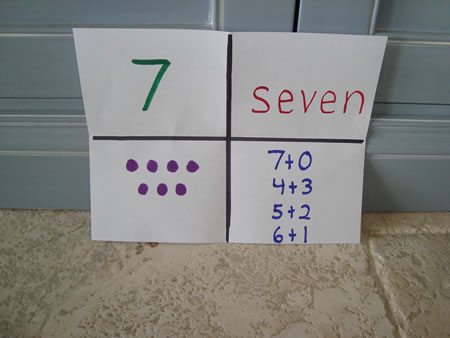

Sing and Spell (Tune: “Row, Row, Row Your Boat”)
Sing and spell with me;
It’s easy as can be.
Just sing a song
And learn along -
It’s so much fun, you’ll see.
Z-e-r-o spells zero,
O-n-e spells one,
T-w-o spells two,
Now we’ve just begun.
T-h-r-e-e, three,
F-o-u-r, four,
F-i-v-e, five,
Now let’s spell some more.
S-i-x spells six,
You’re spelling like a pro.
S-e-v-e-n, seven,
Three more numbers to go.
E-i-g-h-t, eight,
N-i-n-e, nine,
T-e-n spells ten,
Let’s spell them one more time.
Zero - z - e - r - o
One - o-n-e
Etc.
Write words on sentence strips and hold up as you sing.
Make puzzles by writing number words on sentence strips. Cut between letters and place in an envelope. Write the number word on the envelope as well. Children remove pieces and put the puzzle together to spell words.
Line Up - Tap children as you say their position when they line up. For example, “first,” “second,” “third,” “fourth,” etc.
Toy Talk - Line up classroom toys and then orally say their position. Next, ask children to bring you toys by calling the ordinal position. For example, “Who can bring me the fourth toy?”
Piggy Sticks - Make piggy sticks by gluing pigs similar to the one shown on craft sticks. Retell “This Little Pig” using ordinals.
The first little pig went to the market.
The second little pig stayed home.
The third little pig had roast beef.
The fourth little pig had none.
The fifth little pig cried, “Wee wee wee” all the way home.
The sixth little pig ate some pizza.
The seventh little pig ate a pear.
The eighth little pig had spaghetti.
The ninth little pig’s plate was bare.
The tenth little pig cried, “Wee wee wee, I will share!”
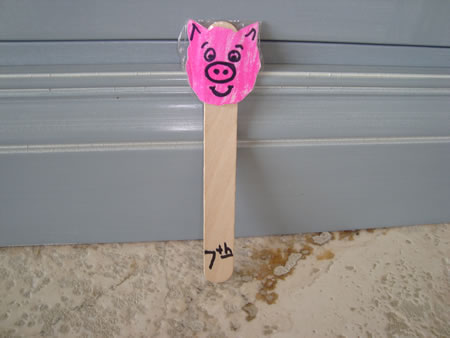
Guess and Check - Give each child a zip bag to take home and fill with objects. (Give them parameters for this, such as 1-10 or 1-25.) Number each of their bags. Classmates write down the number of the bag and then write down their estimation (“guess”) of how many objects are in the bag. Next, they open the bags, count, and write down the correct amount (“check”).
Estimation Center - Fill a plastic bottle or jar with different objects each day. Place small pieces of paper and a pencil by the “estimation jar.” Sometime during the day ask students to write their name and estimation on a piece of paper. At the end of the day, empty the container and count. Who guessed the closest amount? Who guessed more? Who guessed less?
Fraction Pizza (Tune: “He’s Got the Whole World in His Hands”)
I’ve got a whole pizza in my hands. (Extend arms in a circle.)
I’ve got a whole pizza in my hands.
I’ve got a whole pizza in my hands.
And now I’ll eat some up.
I’ve got half a pizza… I’ve got ¼ of a pizza… I’ve got 1/8 of a pizza…
I’ve got no pizza in my hands…
It’s just an empty pan.
Cut a red sheet of paper into a circle and then cut into fractions. Hold up the pieces as you sing the song.
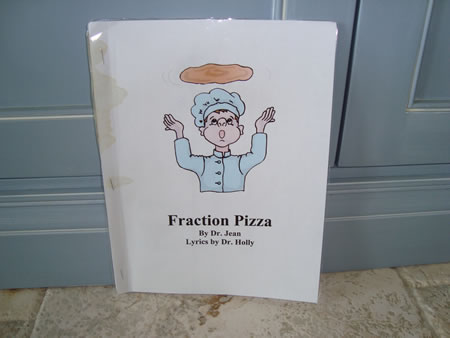
Eating Fractions - Order a large pizza for your class and sing the song as you cut it into enough pieces to share. (You might need two pizzas if you have a large class!)
*Give children a large graham cracker. Can they break it in half? Can they eat half? Can they break it in fourths? Can they eat one fourth? Can they break it in eighths? Can they eat one eighth?
Fractions Puzzles - Have children bring in food boxes from home. Cut the fronts off the boxes and use them to make fraction puzzles.
Problem Solving - You can use blocks, crayons, or other classroom objects for problem solving. For example, invite four children to come to the front of the room. Take twelve blocks and ask the other students how you could share the blocks with those four friends.
Bring in 12 packages of crackers. Count together. “What can we do? There are 24 people in our classroom and only 12 packs of crackers.”
Found a Penny (Tune: “Found a Peanut”)
(Hold up real coins or cut outs as you sing.)
Found a penny, found a penny, found a penny just now.
It is round and brown and shiny
Found a penny just now.
I see Lincoln, I see Lincoln, our sixteenth president,
On the back is his Memorial
Penny, penny’s worth one cent.
Found a nickel, found a nickel, found a nickel just now.
It is round and fat and silver
Found a nickel just now.
I see Jefferson, I see Jefferson, our third president
On the back his Monticello
Nickel, nickel’s worth five cents.
Found a dime, found a dime, found a dime just now.
It is thin and small and silver,
Found a dime just now.
I see Roosevelt, I see Roosevelt, our thirty-second president
On the back is a torch.
One dime is worth ten cents.
Found a quarter, found a quarter, found a quarter just now.
It’s the largest of all the coins,
Found a quarter just now.
I see Washington, I see Washington, our first president
On the back the bald eagle;
Quarter’s worth twenty-five cents.
Found a dollar, found a dollar, found a dollar just now.
It has a picture of George Washington
And it’s worth one hundred cents.
Five pennies equal a nickel; ten pennies equal a dime.
Twenty-five pennies in a quarter,
Two nickels equal a dime.
Five nickels in a quarter, or a nickel and two dimes;
Four quarters in a dollar
And a dollar equals ten dimes.

Rubbings - Have children do rubbings of coins. Place each coin under a sheet of paper and rub with the side of a crayon. Who do they see? What’s it worth? Let children examine coins with a magnifying glass. Encourage them to discuss details. How old is the coin?
Money Song (Tune: “Shortnin’ Bread”)
Chorus: I like money to buy things at the store. (Point to self.)
Money, money, money, I always want more! (Palms up and shake.)
A penny’s worth one cent. (Hold up 1 finger.)
A nickel’s worth five. (Hold up 5 fingers.)
A dime’s worth ten cents. (Hold up 10 fingers.)
A quarter’s twenty-five. (Open and shut hands for 25.)
Chorus
Lincoln’s on one cent.
Jefferson’s on five.
Roosevelt’s on ten cents.
Washington’s on twenty-five.
Chorus
A building’s on one cent.
A building’s on five.
A torch is on ten cents.
An eagle’s on twenty-five.
Chorus
Hint! Feel free to change the words of the song to “Let’s learn some more!” instead of “I always want more.”
Penny Time Line - Let children make a penny time line. First, have them write the year they were born and subsequent years on a sentence strip similar to the one shown. Let them take this home and look for a penny with each date. Tape the pennies to the time line.
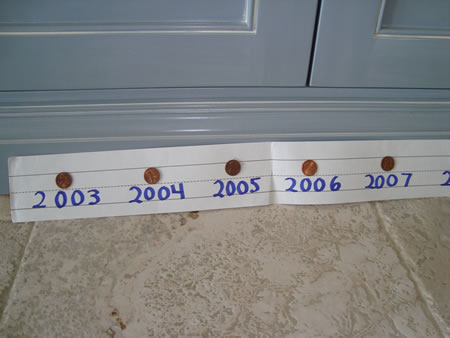
Change Please - Draw four square on a file folder. Label with “penny,” “nickel,” “dime,” and “quarter.” Give children a coin purse with change and ask them to sort the coins. Can they count the total amount?
Coupon Clippers - Bring in coupons and have children cut them out. Ask children to sort the coupons. Can they sort them another way?
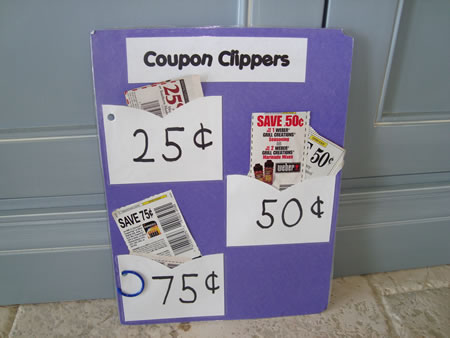
Wants and Needs - Have children use a T-chart to write or cut out pictures of things they “want” and things they “need.”
Money Tree - Does money really grow on a tree? Where does money come from? Have children go home and interview their parents to find out how they make money for their family.
Pay Day - Brainstorm how you pay for things when you go to a store? Do your parents use dollar bills, checks, or credit cards? Run off pretend checks for the children to fill in. Let children make play credit cards by cutting 2” x 3 ½” rectangles out of Styrofoam plates.
Addition Pokey (Tune: “Hokey Pokey”)
Put 1 finger in. (Hold up finger on right hand.)
Put 1 finger more. (Hold up 1 finger on left hand.)
Shake them altogether (Roll around.)
And then lay them on the floor. (Place on floor or table.)
Add them both together, (Bring hands together.)
And you don’t want to stall.
Now you have 2 in all.
2 fingers…3 fingers…4 fingers…5 fingers
*Do “Addition Pokey” with other facts.
Signs for Math - Introduce sign language for equal (fingers straight and bring tips together), addition (open fingers and then bring tips together), and subtraction (pretend to take something out of palm and throw it down). Put fingertips together for “more,” and pretend to push down with one palm on the other for “less.”
Incredible Equations - Each day let children brainstorm equations that would equal the date. Start doing this as a large group activity, and then have children do it independently or with a partner.
Domino Addition - Let children add up dots on dominoes.
“Egg”cellent Math - Write math problems on plastic eggs with a permanent marker. rite the answer on a small sheet of paper and place it inside so children can self check.

Math Flash - You can make this simple game from a spiral ring of index cards. Write math facts on the front of the index cards with a marker. Write the answer on the reverse side with a pencil. Children add or subtract and then check their answer on the reverse side.
